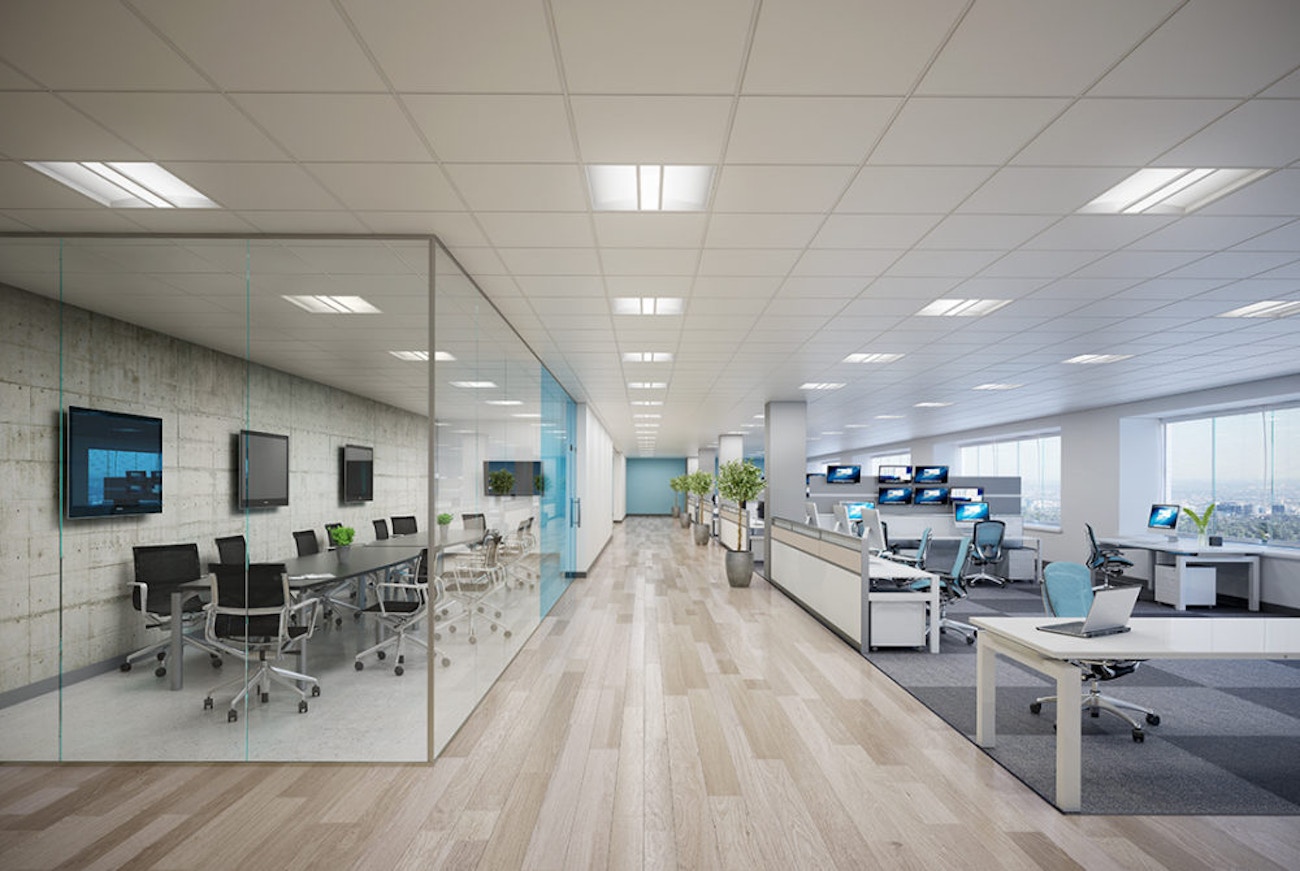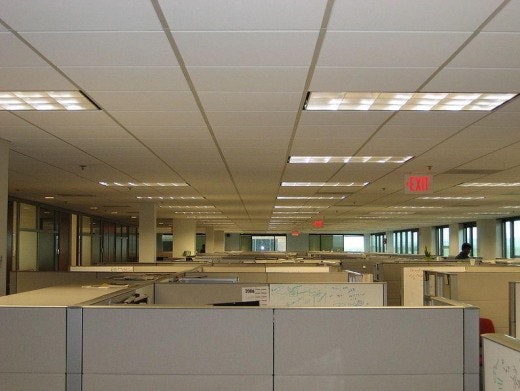Blog
Workplace Lighting and Good Health

Author: Alex Beeston
Lighting design can truly enhance a workspace, transforming it from somewhere that is functional to an environment that enhances the lives of your employees.
Plants have different requirements for light in order to survive and ultimately flourish. Humans are no different. We also need light to thrive. Productivity and creativity can all be enhanced with effective workspace lighting solutions.
With an increased focus on mental and physical wellbeing in today’s workplace, the correct lighting can dramatically impact your employee’s motivation and positivity, feeding directly into staff morale and overall job performance.
Therefore, it’s crucial that we understand the role of modern office lighting and how different lighting can affect the health of your employees.
How does lighting impact the work environment?

Good lighting in the workplace is especially important for the health and wellbeing of your employees. Studies have shown that good lighting not only makes completing tasks considerably easier but also has a positive impact on health and can be used to encourage alertness and productivity.
If lighting levels are too low or even too high, the ability for a worker to complete certain tasks safely can be put at risk.
The negative impacts of poor workplace lighting
Poor lighting can lead to fatigue and eye strain, often developing into headaches and even impaired judgement. This is especially so in environments where more manual type work is required.
Proven research into the effects of lighting quality on workers has concluded that insufficient or inappropriate lighting adversely affects productivity and work efficiency. Additionally, workers were found to be more susceptible to occupational illnesses.
Some of the more common side effects on health connected with inadequate lighting in the workplace are:
- Headaches
- Lethargy
- Eyestrain
- Poor concentration/lack of mental alertness
- Neck, back, and shoulder pain
- Tripping, slipping or falling
- Depression
- Anxiety
Requirements for effective workplace lighting
The right illumination level can improve employees’ visual perception, productivity, and mood and reduce the likelihood of staff developing signs of physical and mental fatigue.
The factors that create an ideal lighting environment include:
- Nature of the light source
- Positioning
- Mounting height
- Luminaire type
- Light distribution
To avoid any adverse effects caused by poor lighting, there are a few simple initiatives you can implement that will help you create a more efficient workplace:
- Increase lighting to an appropriate level for the tasks performed
- Reduce glare from light sources and reflective objects
- Ensure proper contrast of light
- Remove any instances of flickering
Getting these lighting elements right in the workplace is essential to ensure your employees are healthy and safe.
Different types of workplace lighting

There is no one-size-fits-all solution when it comes to office lights. Different workplace activities require different levels of light, so you must tailor your lighting type to suit the needs of your employees to create the ideal working environment.
Generally speaking, the more detailed the tasks performed by your staff, the greater requirement for dedicated lighting. For example, an architectural designer might need bright, direct lighting to illuminate drawings, where as a data processor might require a more controlled lighting arrangement that diffuses glare and glow.
The three most common types of workplace lighting found in offices worldwide include incandescent, fluorescent, and LED.
While incandescent bulbs have utility in accent or task lighting, and fluorescent lights produce a broad scope of illumination in open spaces, by far, office LED lighting is considered the superior solution for workplace lighting.
LED lights offer several advantages over their older counterparts, including a longer lifespan, low wattage with a high lumen output, and extreme versatility. They are suitable for a range of office lighting such as flat panel, suspended, and recessed light fixtures.
Flat panel light fixtures
Flat panel ceiling lights provide the traditional office-style lighting you might expect to find in an open plan working environment. Utilising LED bulbs in either an edge-lit or back-lit panel fitted in line with ceiling panels, this type of lighting offers a bright, practical light source that creates a wide illumination area across your office space.
Suspended light fixtures
Your office setting may require a more nuanced lighting solution in contrast to installing largely functional flat panel fixtures in your ceiling. Linear light fixtures suspended from high ceilings can provide a more subtle, diffused light that is easy on the eyes while also creating an aesthetically-pleasing working environment that promotes creativity.
Recessed light fixtures
Similar to flat panel light fixtures, recessed lighting or downlights are fitted into the ceiling at evenly spaced intervals. However, where flat panels provide a more conventional, widespread light source, recessed lighting offers modern, highly directional illumination that orientates light downward. This type of lighting can also create the illusion of space in a small office due to the fixtures’ inobtrusive design.
Your office environment may benefit from one or a combination of all three types of light fixtures according to the specific tasks your workers perform. In fact, studies have shown that staff morale is greatly improved when employees are given individual control over the illumination of their personal workspace.
Therefore, having direct or task-based lighting available to staff, in conjunction with more general workplace illumination can increase positivity, energy, and productivity.
The importance of natural light

In addition to choosing the right artificial lighting for wellbeing, considerable thought should be given to incorporating natural light into office spaces. Research conducted on the effects of natural light on office workers shows that employees who were exposed to natural light within the workplace were significantly less likely to experience eye strain, headaches, and blurred vision.
Workers also reported better sleep quality than employees who did not experience natural light in their office environment. It’s because this type of light helps regulate hormones and the body’s sleep-wake cycle, often referred to as human circadian rhythms.
Light is directly responsible for how your body responds to the time of day. Low light levels during the day gets you drowsy because sleep signals are sent to your brain. Conversely, artificial light at night can make it difficult for you to fall asleep. It has been found that when workers are well-rested, with more than six hours of sleep per night, productivity increases along with improvements in concentration and mood.
Where possible, natural light should be maximised, especially in open-plan or heavily used spaces within the office. Installing floor-to-ceiling windows and central skylights can provide excellent illumination that works hand-in-hand with artificial lighting techniques to create a healthy workspace that supports mental and physical wellbeing.
For office environments that cannot access natural light due to location or structural limitations, consider lighting design that imitates daylight to reproduce the positive effects natural light has on circadian rhythms. Natural light lamps are a great option. Light levels, colour, and placement will all contribute to creating the desired illumination. A good lighting consultant can help you achieve these results.
Overall, with a proven link between lighting and circadian rhythms directly impacting staff efficiency and wellbeing, a strong focus must be placed on incorporating natural light into your workplace to create a happy and productive environment.
Making the workplace energy-efficient
Beyond the productivity and overall wellbeing benefits of good lighting to employees, you can make significant savings by using energy-efficient lighting, perhaps complemented with solar tubes to help increase natural daylight.
There are several options for reducing energy consumed by office lighting. These can include:
- Using LED light bulbs
- Setting up motion-sensor lighting in low use areas
- Installing dimmers when maximum illumination is not required
- Putting lights on a timer to automatically switch off at designated times
In conjunction with maximising natural light, investing in energy-efficient lighting technology will allow your workplace to decrease power consumption considerably while taking full advantage of the many benefits of natural daylight.
Working from home (WFH) or lighting for the home office
After the events of the past few years, many workplaces have been slowly implementing permanent working from home arrangements. This means your employees require a home office set-up, but getting the best lighting for a home office is something that should not be overlooked just because you no longer share the same space.
Existing ambient home lighting will not be adequate for functional lighting in a home office. Your staff will need to implement lighting concepts usually reserved for the workplace, such as adding task lighting to their space. A desk lamp provides direct illumination for the task at hand. Employees may find it extremely helpful to place an adjustable light source over areas where they will perform work.
Above-desk lighting can create glare. Therefore, finding ways to diffuse ambient light will soften the harsh effects, such as using upward-facing floor lamps that bounce light off the walls and ceiling.
It’s important to remember that lighting in the home office has just as much impact on employee productivity and wellbeing as that of a large open plan workspace.
Healthy workplace lighting design with Hampshire Light
With so many factors involved in effective lighting design, whether in the workplace or a residential environment, Hampshire Light is available to assist you.
Get in touch with our expert lighting design consultants to freely discuss your requirements in detail and find the solutions that’s just right for you.